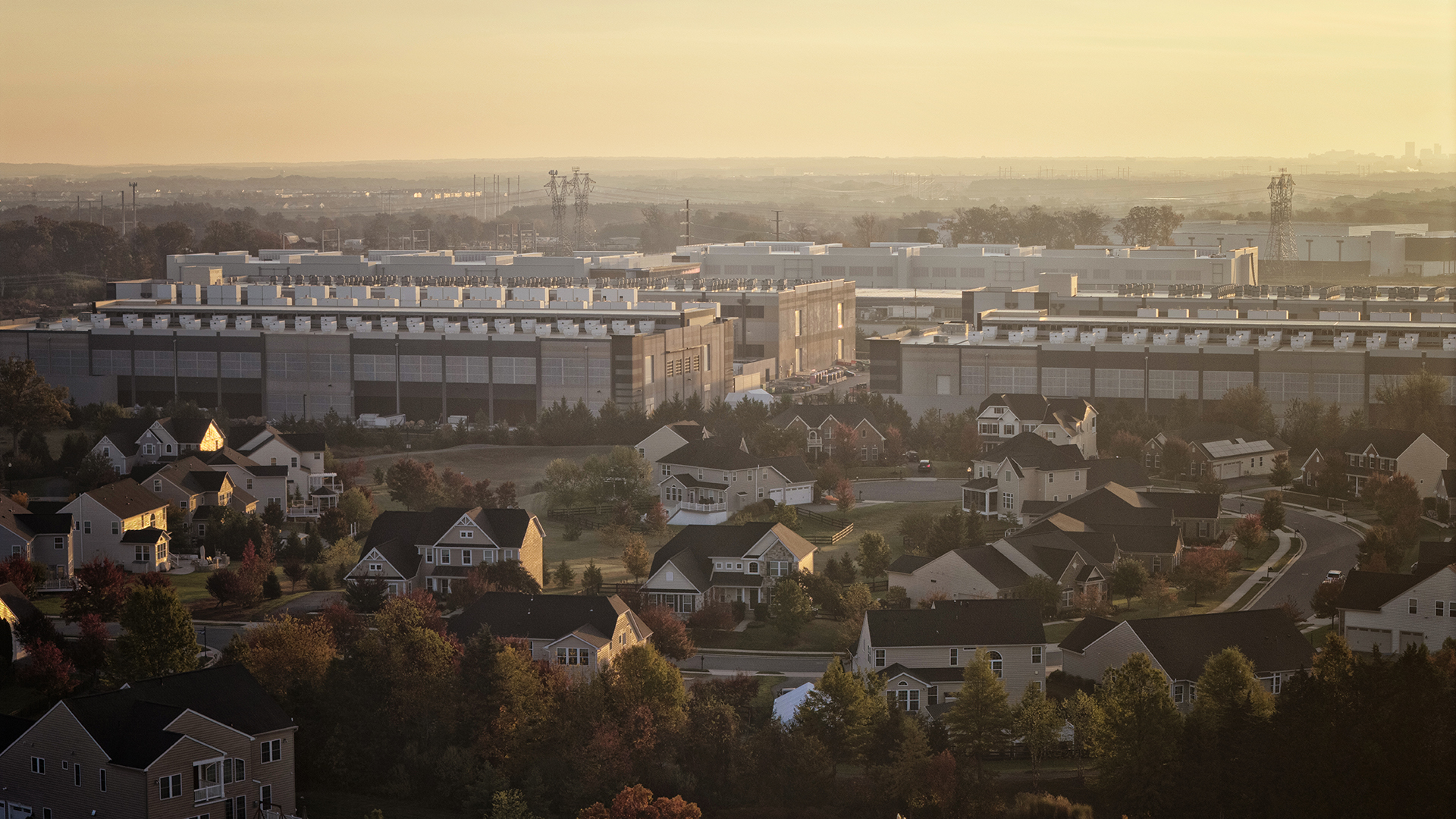The exponential rise of Artificial Intelligence (AI) has prompted plenty of debate—and more than a bit of handwringing—from those praising its potential across industries to those warning of the challenges it’s sure to bring. The potential in both directions is daunting, for sure. Setting aside the speculation and anticipation about what AI may ultimately enable humankind to accomplish, and the moral/ethical tangles attached, we’re going to focus on the myriad questions about its potential strain on global resources and infrastructure and those implications writ large in the context of climate change.
From the thousands of new data centers being planned to proposed nuclear plants (both new and reactivated), aging and inadequate power grids, increasing water demands, and the issues of equity and access surrounding these essential resources, the challenge ahead will be both complex and far-reaching.
AI BY THE NUMBERS
In beginning to approach these issues, it would be helpful to identify at least a few key statistics that may help frame the conversation, so let’s start with these “at scale” stats:
- As of 2024, 82% of global energy is comprised of fossil fuels.1
- Four countries currently comprise 48% of the worldwide demand for electricity: China 27%, U.S. 12.5%, India 4.6%, and Russia 3%.2
- By 2030, Data Centers could account for 21% of the overall global energy demand.3
- About 1.18 billion people worldwide are energy poor and unable to use electricity. Additionally, 750 million people live without reliable access to electricity, and another 447 million people do not use electricity, despite being electrified due to infrastructure, cost, and other issues.4
- A Morgan Stanley report estimates by 2028, AI data center water use could rise by 11 times 2024 levels to over 1,000 billion liters per year, putting it in direct competition with households and agriculture for the world’s limited water resources.5
- Globally 1.1B people lack access to safely managed drinking water, and 2.7B find water scarce for at least one month of the year.6
These are startling numbers, and they begin to paint a picture of the challenges we face in just achieving equitable distribution of resources, let alone meeting such a fast-growing demand. While AI certainly isn’t the only culprit, its rapid growth is predicted to be a major drain on resources and a strain on existing infrastructure. This creates significant concerns about sustainability and resilience, as well as equity and access for those on the margins of our current infrastructure. Additionally, these statistics raise important questions about why we are rushing to build so much so quickly, before we’ve developed solutions for the cascade of issues that we can already see emerging.
ASKING THE TOUGH QUESTIONS
So, what are we to do?
We clearly can’t stop the train, but while it’s revving up to full speed, we should be asking tough questions about the value proposition of accelerating things we know will exacerbate the problem. Questions like:
- “Is it possible to curb, offset, or negate the significant demand increases for power and water?”
- “How will we address and prioritize that demand given the current shortcomings of our existing infrastructure in terms of reliability, resilience, and equity?”
- “(How) will we balance the needs of the general population with the few corporations that will own AI?”
- “Can we rely on AI to solve a problem that it is essentially a significant contributor to?”
- And, finally, “Even if it could solve the problem, would we actually implement that solution?”
I ask that last question because it seems to me that we don’t need AI to tell us (again) the things we already know about the trajectory of climate change. Nearly all climate science urgently calls for moving away from fossil fuels to renewable energy and reducing greenhouse gas (GHG) emissions before we reach the tipping point. Yet, we continue to struggle to act on that knowledge. And not just accepting that consensus, we keep making moves that unravel progress towards those goals.
I think the answer to these questions will have to come from the collective “us”—with all constituent groups fairly represented and an equation that considers much more than how much profit is involved for a few companies.
I asked ChatGPT this question: “Can AI grow as expected without negatively impacting efforts to slow and reverse climate change?” Its conclusion:
AI’s growth is not inherently incompatible with climate action—but without deliberate intervention, it risks becoming a major driver of emissions and resource depletion. The key lies in aligning AI development with sustainability, through innovation, regulation, and global cooperation.
ALIGNING AI DEVELOPMENT WITH SUSTAINABILITY
Seems like a reasonable starting point—one that spreads the responsibility for measured intentional action across scales of influence. Aligning AI development with sustainability is something we should recognize as a “must” in the list of criteria to meet balanced goals. There’s no way we can afford to let this siren call technology unravel decades of progress in greenhouse gas reductions.
Innovation must come from anywhere and everywhere that we can find the will to support research and development of new processes and technologies that can minimize or negate AI’s impact on energy use. Small start-ups that are nimble enough to iterate and change direction as needed. Mid-size and larger companies that have the resources to develop multiple ideas and bring them to market for testing. And innovation may come from AI itself.
Regulation will be a challenge, but not an insurmountable one. Data centers should probably become a special-use category with more stringent resource management and energy/water performance criteria. This must be coordinated at a national level to avoid them all being built where the regulations are lax in comparison to a neighboring jurisdiction and to prevent inequitable drain of resources in any region.
Global cooperation could well be the place it falls apart, though there are signs (at least outside the US) that a strong collective can help to hold the line on sustainable development requirements. Currently, the US has 51% of the world’s hyper-scale AI facilities, but we can be sure other countries are fully invested in the race for AI dominance.7 Questions of how to agree on and implement worldwide standards will certainly be slow in developing, but again, other countries may become the progressive leaders we need. Either way, we’ll need strong coalitions, shared technology, and a way to balance the common good against pure profit, finding a way for both to matter.
WHAT WE CAN DO TO LIMIT AI’s GHG EMISSIONS
It’s projected that by 2030, 70% of the world’s data center capacity will be dedicated to AI.8 Coupled with existing baseline issues of our reliance on fossil fuels, aged infrastructure, and current levels of inequity, near-term demand could potentially negate any progress made in other market sectors and easily push us to that critical tipping point on GHG emissions. But let’s not give up that fight.
Things we can do include:
- Stay engaged and informed.
This conversation will be a long one, with plenty of twists and turns. Make sure you get past the surface to the (verified) details so you can make informed choices. - Exercise personal restraint and responsibility.
While exact numbers are hard to pin down, it’s clear that AI uses substantially more energy and water than a simple web or Google search. Minimize your personal AI footprint by using AI cautiously and not for frivolous purposes. Encourage and contribute to the development of responsible AI guidelines at your place of work. - Support and invest in the development of available renewable energy technology.
Vote with the dollars you spend and through your political representatives to help break the hold of fossil fuels as our primary energy source. Advocate for sensible regulations Data Center development and on fossil fuels and support the transition to renewable energy as our primary source for all future energy needs.
CHARTING A RESPONSIBLE PATH FORWARD
Ultimately, the trajectory of AI doesn’t have to be a zero-sum game with climate action, but it will be if we fail to act intentionally with specific performance metrics in mind. The challenge before us is not only technological, but social, political, and ethical: ensuring that innovation advances human progress without exacerbating inequity or environmental strain. Achieving this will require collaboration across governments, corporations, and individuals, guided by foresight, restraint, and shared responsibility. The choices we make today—in how we build, regulate, and use AI—will determine whether it becomes a tool for sustainable growth or a driver of further ecological imbalance. There is no single solution, but the path forward begins with deliberate, collective action, and we can all play a part in the outcome.
RESOURCES
- Igini, Martina. “Fossil Fuels Accounted for 82% of Global Energy Mix in 2023 Amid Record Consumption: Report.” Earth.org. https://earth.org/fossil-fuel-accounted-for-82-of-global-energy-mix-in-2023-amid-record-consumption-report/ ↩︎
- “Electricity consumption worldwide in 2024, by leading country.” Statista. https://www.statista.com/statistics/267081/electricity-consumption-in-selected-countries-worldwide/ ↩︎
- Stackpole, Beth. “AI has high data center energy costs – but there are solutions.” MIT Management Sloane School. https://mitsloan.mit.edu/ideas-made-to-matter/ai-has-high-data-center-energy-costs-there-are-solutions ↩︎
- Min, Brian; O’Keefe, Zahcary; Abidoye, Babatunde; Mensan Gaba, Kwawu; Monroe, Trevor; Stewart, Benjamin; Baugh, Kim; Sanchez-Andrade, Bruno; Meddeb, Riad. “Beyond access: 1.18 billion in energy poverty despite rising electricity access.” World Bank Blogs, Data Blog. https://blogs.worldbank.org/en/opendata/1-18-billion-around-the-world-are-unable-to-use-electricity ↩︎
- The Economic Times. “AI data centers to drive 11-fold rise in water consumption by 2028: Morgan Stanley.” September 8, 2025. https://economictimes.indiatimes.com/tech/artificial-intelligence/ai-data-centers-to-drive-11-fold-rise-in-water-consumption-by-2028-morgan-stanley/articleshow/123755912.cms?from=mdr ↩︎
- World Wildlife Foundation. https://www.worldwildlife.org/our-work/freshwater/water-scarcity/ ↩︎
- PGIM. https://www.pgim.com/us/en/institutional/insights/outfront/hyperscale ↩︎
- “AI power: Expanding data center capacity to meet growing demand.” McKinsey & Company. https://www.mckinsey.com/industries/technology-media-and-telecommunications/our-insights/ai-power-expanding-data-center-capacity-to-meet-growing-demand ↩︎

